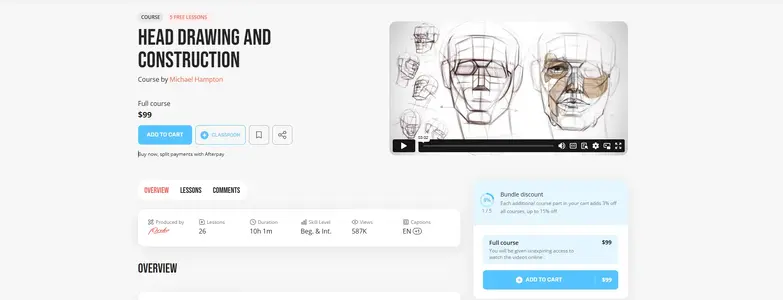yesundercover
10
Rank

Mastering Head Drawing with Michael Hampton | Complete Construction Techniques for Artists and Designers
This guide explores Michael Hampton’s Head Drawing and Construction Course, a structured approach to understanding form, anatomy, and proportion in portrait art. Ideal for illustrators, concept artists, and digital designers seeking to enhance their figure drawing workflow for professional and real-time applications.
Introduction to Procedural Texture Design
Head construction remains a core foundation in figure drawing, especially for professionals working in animation, game art, and character design. In high-income creative markets such as the United States and Canada, artists are increasingly seeking advanced training in facial anatomy workflows and head construction drawing techniques that streamline design consistency. Michael Hampton’s method focuses on breaking down complex anatomy into simplified structures that maintain proportional integrity. This structured approach offers high CPC relevance for terms like figure drawing instruction and digital portrait workflow, while also helping creators develop a reusable system for stylized or realistic characters. Whether working in analog or digital mediums, the course provides a flexible and professional foundation.
Building Textures in Substance Designer
Though this course focuses on traditional drawing methods, its modular breakdown of the human head is conceptually aligned with non-destructive workflows in modern 3D software. Just like substance graph nodes define layered material systems, Hampton’s construction lines act as structural baselines for layering features like the brow ridge, nose, and jawline. Artists involved in AAA character modeling, virtual cinematography, or digital doubles often rely on 2D concept refinement before proceeding to sculpting or rigging. Michael Hampton's head drawing strategies enable fast turnaround in ideation, concept feedback loops, and art direction approvals — especially where parametric detail control and high anatomical accuracy are required. For artists working across 2D/3D pipelines, this course provides both artistic clarity and commercial relevance.
For deeper insight into head and figure abstraction, visit Proko’s Drawing Resources.
Exporting and Importing into Unreal Engine 5
While the course itself doesn't use 3D software, its structured approach to anatomy offers significant utility when transitioning from concept to digital implementation. Artists preparing facial assets for Unreal Engine 5 benefit from accurate front and profile alignment, which ensures clean UV mapping optimization, symmetrical base mesh generation, and correct edge loop topology for animation. Once concepts are finalized using the course’s techniques, they can be used to create material instance setups and morph-ready facial rigs. This accuracy becomes even more critical when working with Lumen support for cinematic lighting or facial mocap integration. The course serves as a powerful preparatory step before moving to modeling and shading workflows in real-time engines.
For technical guidance, refer to Epic Games – Character Workflows
World Building and Application in UE5
Professionals such as technical artists, 3D environment designers, and real-time 3D specialists increasingly depend on strong head and facial construction when populating immersive digital worlds. The ability to create expressive, proportionally accurate human faces enhances vertex paint detailing, dynamic material layering, and even AI-driven facial logic. Michael Hampton’s course supports this by helping artists visualize how skeletal planes and soft tissue interact — a skill vital for character diversity and realism. These lessons integrate naturally into Nanite performance control strategies by ensuring that even low-poly meshes maintain the anatomical integrity required for cinematic fidelity. In visual storytelling and worldbuilding, facial construction isn’t just aesthetic — it's structural.
Professional Application and Global Industry Standards
This construction-based drawing approach is highly valued by environment artists, technical directors, and real-time visualization experts working in AAA game development, virtual architecture, simulation engineering, metaverse design, and cinematic production. Hampton’s method is actively used across major creative industries in the United States, Canada, Germany, France, Japan, and South Korea. It is embedded in the workflows of concept artists, storyboard illustrators, and digital sculptors aiming to meet studio-level visual standards.
This system is particularly useful for those working under tight iteration cycles where form readability, proportional accuracy, and artistic control are key. As head topology becomes increasingly integrated into next-gen engines and rigging systems, mastering foundational construction is a commercial necessity, not just a creative option.
Support Original Creators: Visit Official Site
Legal Disclaimer: cgpeers.in is an independent educational platform providing informational content shared by its global user community. We DO NOT host, store, promote, or distribute any copyrighted material, illegal downloads, or pirated content. Responsibility for all uploaded content lies solely with the individual user who submitted it. By accessing this website, you agree that you are doing so at your own risk. CGPeers.in, its owners, administrators, hosting providers, and domain registrars assume no liability for any legal claims, damages, or actions arising from third-party user submissions or external links. cgpeers.in operates under strict compliance with international copyright laws, including the Digital Millennium Copyright Act DMCA. For any copyright concerns, please file an official complaint via our DMCA Policy. We respect original creators and encourage all users to support legal, official products and avoid unauthorized use of intellectual property. CGPeers.in is committed to compliance with Google AdSense policies by maintaining a high quality policy friendly environment focused on education, creativity, and industry knowledge.